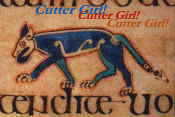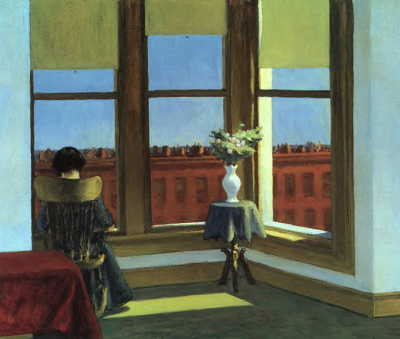
Cutter Girl! A Librarian Resource Haven
|
What Happened?! Cutter Girl! Lit News Archive

Catch up on all the book news you missed when it was on the Cutter Girl! Reading page. News items are in reverse chronological order, with the more recent items at the top of the page.
Both news items at the moment involve two of my favorite writers...
June 2002 - James Joyce Manuscripts
The National Library of Ireland has acquired a very large collection of previously unknown James Joyce manuscripts, notebooks and workbooks at a cost of £8 million sterling.
The acquisition is being funded, over a three year period, from the Heritage Fund, established last year by the Minister for Arts, Heritage, Gaeltacht and the Islands, Síle de Valera TD and with support from the AIB Group under the tax credit scheme.
The materials acquired by the Library were the property of Mr and Mrs Alexis Léon, and have been acquired through the agency of Sotheby’s, London. Mr Léon’s parents, the late Paul and Lucie Léon, were close friends of Joyce from 1928 onwards.
"Sotheby's is delighted to have organised the sale by private treaty of this great collection of James Joyce manuscripts. It has been a pleasure working with Mr and Mrs Léon and the National Library of Ireland to bring this about. It is the most important discovery of a collection of literary manuscripts by a 20th century author ever made, and the most valuable ever sold. Sotheby's is proud to have helped to achieve this, " said Dr Stephen Roe, Head of the European Book Division, Sotheby's.
Mr and Mrs Alexis Léon decided that the National Library of Ireland should be given first refusal on the new collection because they hoped it thus would come to the Library to which Mr Léon’s father had donated the extensive collection of James Joyce – Paul Léon letters in 1941. Since the 1940s, major university libraries in the United States, including Cornell, Yale, Harvard, Princeton, Buffalo, Texas and Tulsa, as well as the British Library, have acquired significant collections of Joyce material. As a result of its new acquisition, however, the National Library of Ireland can now claim to be the world’s foremost repository of Joyce manuscripts.
This is, of course, the second major acquisition of Joyce materials by the National Library of Ireland in recent years. In December 2000, the Library acquired the manuscript of the ‘Circe’ episode of Ulysses. In addition to the important James Joyce – Paul Léon Papers, it already holds the first copy of the first edition of Ulysses, presented in 1952 by Harriet Shaw Weaver to whom Joyce himself had presented it in 1922, and the fair copy of A Portrait of the Artist as a Young Man, also a gift from Harriet Weaver.
Because Ulysses is acknowledged as the pre-eminent work of literature of the 20th century and because James Joyce is second only to Shakespeare in terms of the number of published studies of his work, any new discovery relating to Joyce and his work is an important world literary event. In this instance, the scale of the collection is such that Joycean scholars will now need either to reassess or fundamentally revise their work.
The new materials divide into three broad categories: early notebooks; notes and drafts for Ulysses; and proofs and additions to proofs for Finnegans Wake. Details are provided in a separate list. In all, there are over 500 manuscript pages and some 200 pages of proofs, together with some typescripts. The Ulysses material in particular will inspire new avenues of investigation and research, reinvigorate debates on the composition of the text, and add crucial evidence for arguments on the definitive text.
The two early notebooks (1903-04) provide some fascinating glimpses into the young Joyce, while the Finnegans Wake documents fill in some gaps in the record documenting the process of getting that work into print. It is the materials for Ulysses, however, comprising notes, notebooks and documents containing early drafts, which make this collection extraordinary. These will deeply enrich and alter our sense of how Joyce wrote this book and thus change awareness of how literary modernism, as represented by his primary prose work, came into being.
As General Editor of The James Joyce Archive, Michael Groden, Professor of English at the University of Western Ontario, Canada, is the world’s foremost authority on Joyce manuscripts. Professor Groden carried out a detailed assessment of the new collection on behalf of the National Library late last year and reported that the newly acquired Ulysses manuscripts will immediately be seen as “the most important collection of early drafts for Ulysses in the world and will instantly catapult the National Library, and Ireland, into a major centre for the study of James Joyce”.
In support of that view, Professor Groden points out that two of the notebooks include the earliest surviving sets of notes, and that there are drafts of no fewer that nine separate episodes of Ulysses; six of these represent hitherto completely undocumented stages of development; five of them are earlier than anything available up to now for the episodes concerned; and one of them is earlier than any draft of Ulysses that was previously known to survive.
Joyce first referred to “my new novel Ulysses” in mid-1915. In October 1916 he said that he had almost completed the first part as well as parts of the middle and later sections. However, the record of his work during these early years is very sketchy – almost no documents were known to exist until now. This adds immeasurably to the significance of the new collection.
In the new manuscripts, the handwriting matches Joyce’s known handwriting from the different periods of his life. His method of writing his notes and his drafts, and his use of coloured crayon lines and Xs to signal his use of material in later drafts, are perfectly consistent with other surviving documents. Furthermore, several of the documents blend in seamlessly with manuscripts in existing collections. The manuscripts themselves have been rarely touched over the years, and for the most part they are in very good to excellent physical condition.
It will take time for the National Library to fully assess the new collection, to arrange appropriate conservation treatment, where necessary, and to catalogue the collection. At this early stage, it is not possible to say how long these measures will take and when the manuscripts can be made available for consultation by researchers in the Library.
24 May 2002 - National Library Acquires the Library of W B Yeats
The entire personal library of William Butler Yeats, comprising more than 2,500 volumes, has been donated to the National Library of Ireland by the poet’s son, Michael B Yeats and his daughter-in-law, Gráinne.
W B Yeats’s library was maintained by his daughter, Anne Yeats, at her home in Dalkey, County Dublin, until her death last year. It includes books which have been annotated in the poet’s own hand and in that of his wife, George. There are also copies of Yeats’ own published work, many of them showing his own revisions for subsequent editions; these latter provide essential information for tracing the evolution of his texts, especially the plays. There are numerous volumes with inscriptions from contemporaries of Yeats and volumes which were used by him in selecting materials for The Oxford Book of Modern Verse. A significant number of the books in the Library were the property of George Yeats, some of them acquired before her marriage, and some of them her own personal copies of her husband’s work.
Edward O’Shea, who published a catalogue of the Library of W B Yeats in 1985, commented that it “documents in a very vivid way how much Yeats, as one individual opened up his own mind and therefore English literature to multiple and even heterodox influences: to the oriental, the occult, theosophy, magic, myth, the antiquarian, anthropology, philosophy, archaeology, the visual arts, and the list could obviously be extended”.
The National Library is already the world’s largest repository of Yeats papers, a collection which is one of the most significant literary archives in the English-speaking world and was gifted to the Library by Mrs W B Yeats and by the poet’s family in the period since his death in 1939. It comprises thousands of items, including drafts and manuscripts of poems and plays; correspondence between Yeats and other major literary figures; versions and fragments of many of his writings, both published and unpublished; and numerous notebooks, copybooks and files of papers relating to spiritualism, the occult, horoscopes and automatic script.
It is most appropriate, therefore, that the personal library of W B Yeats should also be available to literary scholars at the National Library, where Yeats himself was a regular reader almost from the opening of the Library in 1891. The Council of Trustees and Director of the Library are most grateful to Michael and Gráinne Yeats for making this possible.
The National Library intends to maintain the library of W B Yeats as a special collection which will be separately shelved and have its own series of catalogue numbers. It is planned, as part of the Library’s building programme, to provide a separate Yeats Room where readers will have access to both the books and the Yeats papers held by the Library. Pending this development, and as soon as the books have been processed and catalogued, they will be made available, on an interim basis, to researchers at the Library’s Manuscript Reading Room.
Both preceding news items courtesy of the National Library of Ireland

Image © Corporation of London
Top
|